Corumbá
Corumbá is one of the oldest towns in Mato Grosso do Sul. Although many buildings in the city centre and along the waterfront date from the 19th and early 20th centuries, the town was founded much earlier, in 1778. The oldest structures either didn't endure the passage of time, or were razed during the Paraguayan occupation of the town during the Paraguayan War (1864-70). Most historic buildings that visitors see today date from the post-war period, when the town's strategically important riverport brought new settlers, commerce, and the establishment of new military bases to strengthen the frontier. However, the advent of railways and road transport later caused the region's development focus to shift to other towns such as Campo Grande, Aquidauana, and Dourados - leaving behind the living time capsule which visitors can see today. Recently the town has recognised its heritage, with many old buildings now being restored to their former glory.
Corumbá has the moniker Capital of the Pantanal due to it being the biggest town within the Pantanal boundaries. It's also known as Cidade Branca (the White City) due to the light colour of its soil, which has a high limestone content. The local economy is based on cattle ranching, fishing, tourism, cement production, and maintenance of the Brasil-Bolivia gas pipeline. Several small iron and manganese mines were also operating in the nearby hills until recently.
Although Corumbá is the main town, the immediate region is actually a conurbation with several other towns including:
- Ladário: This is the site of a Brazilian naval base established in 1872 after the Paraguayan War, and the site of the original township;
- Puerto Suárez: On the Bolivian side of the frontier, it has a large shopping mall, banks, hotels, and tours in the Bolivian Pantanal. There's a small airport but currently without any regularly scheduled flights; and
- Puerto Quijarro: Also on the Bolivian side. Not much to see, but its the location of the train station offering transport to Santa Cruz.
Tourism
Until a decade ago, Corumbá was a popular transit point for backpackers travelling to/from Bolivia. The town had several backpacker hostels and was a good location for organising tours into the Pantanal. However, those agencies have moved or no longer exist. Although local hotels can sometimes offer details for a few private guides, their quality can vary significantly. The safest bet for visitors wanting to spend a few days in the Pantanal is to book directly with a lodge or fazenda online - or to use one of the better known agencies operating out of Campo Grande. By contrast, if you want to take leisurely day cruise along the Paraguay river (still a great opportunity to see wildlife) and/or try your hand at fishing then there are plenty of agencies to choose from along the riverfront in the Porto Geral. The agency Zé Leôncio will even let you hire a small boat so you can set your own travel pace.
For Brazilians, Corumbá's tourism drawcard is its fishing, with barco-hotels and fishing lodges providing an an ideal quiet retreat. The town also holds significant events such as its annual carnaval and Festival América do Sul.
Above:Local kids waving promotional giveaways during local elections in Corumbá.
Below: If visiting in late-February/early-March, making time for the annual Carnaval de Corumbá is highly recommended.
Local Events
Corumbá Carnaval
The annual Carnaval de Corumbá occurs in late-February/early-March. Although it's smaller that the famous Rio Carnaval, there's still plenty of spectacle - plus it has the advantage of allowing you to get closer to the action or participate directly. The town's carnaval celebrations grew with the establishment of military bases to guard the frontier after the Paraguayan War. Many of the personnel for these installations were drawn from Rio de Janeiro, and brought their carnaval traditions with them. There are currently around 10 samba schools who compete for two nights along Avenida General Rondon which overlooks the historic waterfront. A third night includes presentations for the town's cultural carnaval. This, together with pre-carnaval block parties and other events, typically run over a two week period. The event regularly attracts visitors from across the region, including the Campo Grande, nearby states, and Bolivia.
Rodeio
Each September, the Semana do Município celebrates the town's anniversary. It includes the Latin American Festival of Arts and Culture, and the Rodeio (Festa do Peão Boiadeiro).
Festival América do Sul
With its position on the frontier, Corumbá is aiming to position itself as a gateway for trade between Brazil and the rest of South America - with most countries having signed up to the South American MercoSul (or MercoSur) trade block. The annual Festival of South America is a celebration of South American culture with shows, exhibits, artists, fairs and organised debates from across the continent. It occurs in late August (recently moved from May) and attracts up to 100,000 visitors per year.
Festa de Nossa Senhora da Candelária
This religious festival is held at the beginning of February each year to celebrate the town's patron saint. This is a public holiday, and there are religious processions led by worshippers carrying a statue of the saint. There's also a bizarre local tradition that involves people throwing buckets of water at each other.
Banho de São João
Baptism of St. John. This religious festival which has been a local tradition for a century or more. A small statue of St John is carried in a procession to the river and baptised. The local port is richly decorated - with music acts and celebrations. Occurs annually in mid/late June coinciding with mid-winter.
Cuisine
With its cattle ranching background, Corumbá's residents appreciate a good barbecue. There's also a strong Paraguayan and Bolivian influence with pastries such as salteñas stuffed with chicken. However, fish dominates in regional dishes with stews made using pacu and large catfish such as pintado. This includes Peixe Urucum made with coconut and cream. Piranha is another local favourite with the Caldo do Piranha fish broth, said to be a strong aphrodisiac. Local restaurants such as Laço do Ouro and Peixaria do Lulu are great places for those wanting to experiment Pantanal regional dishes.
Above:A Barco-Hotel vessel, Cabexy II, built for fishing tours, docked along the Porto Geral riverfront in Corumbá.
Below:Pantanal wildlife-themed souvenirs inside Arte Pantaneira, located on the riverfront in the Porto Geral.
Things to See and Do
Porto Geral
Rua Manoel Cavassa
Porto Geral is the local name for the riverfront. During the town's heyday this was an area of busy warehouses and trading companies. It's much quieter today. Most old buildings have seen better days - but some are now being restored to former glory or, at least, given a fresh coat of paint. They're now occupied by shops selling Pantanal souvenirs or selling fishing tours on the Barco-Hotels which line the riverfront. It's a good place to watch the sunset, watch the river traffic, or observe local bird life such as guira cuckoos, parrots, and an occasional heron. The Museu de História do Pantanal is alo located here.
Museu de História do Pantanal
Rua Manoel Cavassa, 275
Tues-Sat: 1pm to 5pm. Closed on Sundays
Located on the riverfront, this is worth a visit to get insights into man's 8000 year history in the Pantanal region. It also includes photographs and paintings by local artists. The museum is located in the old Wanderley, Baís & Company building which was restored and reopened in 2008.
Memorial do Homem Pantaneiro
Ladeira José Bonifácio, 171
Located in the recently restored Casa Vasquez & Sons building, on the road descending to the riverfront, this houses several other exhibits, although seems irregularly open. The building itself dates from 1909, and was designed by the Italian architect, Martino Santa Lucci. It has a large open hall downstairs with a double-height ceiling, a mezzanine, and a large wooden staircase. The inside is decorated with murals and mosaic tiles. The building was restored in 2006.
Historic old buildings and faded elegance along the Porto Geral riverfront. These are progressively being restored, and date from the pre-rail and pre-road transport era when Corumbá served as the "emporium" of the Mato Grosso territory. This is the old Casa Vasquez & Sons building (photographed pre-restoration) which is now the Memorial do Homem Pantaneiro.
Museu do Pantanal
Instituto Luis de Albuquerque, Praça da República
Weekdays: 8am - 11:30 am and 1pm - 5pm. Closed weekends.
Housed within the large neoclassical building, next to the church, which overlooks the Praça da República. The building hosts two libraries and a small museum containing a collection of archaeological objects, artefacts from local Indian tribes (Kadiwéu, Terena and Bororó), traditional crafts and artworks in leather and clay, old cattle branding irons, and several artefacts from the Paraguayan War - such as the sword of General Antônio Maria Coelho who led the assault to recapture the town. It also includes personal objects from pioneer settlers including Marshal Cândido Rondon.
Igreja de Nossa Senhora da Candelária
Praça da República
Constructed in 1885, this is Corumbá's main church. It overlooks the Praça da República, and caused great controversy before it was even built - triggering the curse that the Italian priest Frei Mariano invoked on the town. Maintenance on the church had been neglected in recent decades, and was closed in June 2016 when parts of its ceiling collapsed. It is currently undergoing restoration and is set to reopen later in 2017.
Praça da Independência
This is a park in the town centre occupying land that was formerly used for a city zoo. It includes several objects dating to the days of the Brazilian Empire - including a band gazebo presented to the town by the Austro-Hungarian Empire, and a set of four Italian marble statues representing the four seasons, in addition to several other monuments. The trees within the park are predominantly native plants such as carandá, bocaiuva and ipê-roxo.
Above:View of the marble statues and historic Gazebo installed in the Praça da Independência.
Below:A historic Marshall, Sons & Co steam roller (circa 1920) on display in the Praça da Independência.
Casa do Artesão
Rua Dom Aquino, 405
From 8 to 11:30 am and 2 to 5:30pm, Saturday: 7:30 to 11:30am. Closed on Sundays.
Founded in 1975, the Casa do Artesão occupies the old city prison which was closed in the 1970s. Local artisans rent the old cells - using the them to display, sell, and produce their work. This includes works in leather, wood, ceramics, weaving, painting, embroidery, indigenous handicrafts and homemade liqueurs.
Casa de Massabarro
Rua de Cacimba, Bairro da Cervejaria From 8 to 11:30 and 13:30 to 17:30. Saturday from 8 to 12 h. Closed on Sundays.
This is a non-profit organisation founded in 1985, teaching and encouraging children in ceramic arts and social education programmes. The artworks made are typically representative of the flora and fauna of the region - but also include some religious works. Artworks are available for sale, with 80% going to the artist, and 20% back to the association. The criteria to join is for children to be aged between 9 and 14 years, and enrolled in school. In 1991, the artworks (and artists) could the eye of legendary Carnaval organiser Joãozinho Trinta, who twice asked them to decorate parade floats for the Rio de Janeiro samba schools Beija-Flor and Viradouro.
Sunday Market
Sundays. Rua Ladário
A open air market is run every Sunday along Rua Ladário, between Rua Delamare and Rua 13 de Junho. Most of the vendors are Bolivian, who bring in fresh produce from their farms across the border - although it also includes cheap clothing, footwear, consumer goods (mostly very poor quality items from China), and lots of pirated CDs and DVDs. It's worth a visit if only to sample the local snacks such as pasteis, and freshly squeezed sugar cane juice.
Sunday market in Corumbá.
Forte Junqueira
Visits by arrangement with Army information Office.
Located in a high area overlooking the Pantanal and Paraguay River, the fort is one of several constructed immediately after the Paraguayan War, as part of a plan to ensure the defensibility of Corumbá. The walls are a half metre thick, and the armament consists of 12 80mm Krupps cannons manufactured between 1872 and 1874. The fort is located within an area which is now the barracks of the 17th Frontier Battalion.
Cristo Rei do Pantanal
Morro São Felipe
Giving the town a small flavour of Rio de Janeiro, Cristo Rei do Pantanal is a 12m statue and lookout installed on the São Felipe hill overlooking Corumbá and the Pantanal. The statue was made by the local artist Izulina Xavier. The easiest way to visit is by private car or taxi.
Above: Cristo Rei do Pantanal statue. This is located on a hillside behind Corumbá - overlooking the town and the Pantanal.
Below: View looking down over Corumbá at dusk from Morro do Cristo Rei.
Surrounding Area
Forte Coimbra
Visits by arrangement with Comando Militar do Oeste
Built in 1775 to defend the frontiers of the Portuguese (and later Brazilian) Empire from incursions from its Spanish neighbours, Forte Coimbra is located on the banks of the Paraguay River, several hours by boat south of Corumbá. This was the site of the first major engagement of the Paraguayan War when the forced of Francisco Solano López invaded Brazil - capturing much of the southern Mato Grosso territory. A Brazilian force of 157 held off over 4,000 Paraguayan soldiers for several days before slipping out unseen. The fort is still a occupied by the Brazilian military but has seen increased tourism in recent years.
Parque Marina Gatass
Rodovia Ramos Gomes
Located near the border with Bolivia, this park is the largest park in the city area. It covers a forest area of 6 ha, with plenty of shade and lawn to relax. It's also the location of an important archaeological site. The park was built in 1991, with a view overlooking Baía do Tamengo - a lake situated mid-way between Corumbá and Puero Suarez.
Caimasul Caiman Farm
BR 262, Km 741
Located in a rural area about 30km from Corumbá, this caiman farm is still relatively new - with tours still being by arrangement only. Visitors can get up close and personal with caiman (jacaré) of all sizes. Eggs are hatched in large incubator chambers - with caiman being raised in enclosures separated by size. Once they reach the right size (about 8kg) they are humanely slaughtered for meat and leather products.
Estrada Parque
This is the southern Pantanal equivalent of the transpantaneira. It's an unpaved road servicing several remote Pantanal communities and cattle ranches in the area between Corumbá and small town of Buraco das Piranhas. It covers 120km, includes 87 wooden bridges, and several wooden observation observation towers. The wildlife is most concentrated after the ferry crossing across the Paraguay River at Porto da Manga.
As with the transpantaneira this is one of the best opportunities to view wildlife - looking down on jacaré while crossing bridges (these can also be a good fishing spot), or viewing animals as they cross the road. Importantly, it also provides road access to several local fazendas and tourist lodges - although is best avoided in the wet season (Nov-Apr) when it turns to thick boggy mud. A small fee is charged to vehicles carrying tourists by the Environmental Police (and administered by SEMATUR, the municipal tourism board) to help pay for the upkeep. Travel is recommended only during the day, as crossing the bridges at night can be be treacherous.
Tourists swimming in a Pantanal river while on a boat trip out of Corumbá.
Washing day at the Porto da Manga ferry stop. This ferry is needed to take vehicles across the Paraguay river when travelling along the Estrada Parque.
Curva do Leque
This is a small community on the Estrada Parque road. Although there's not much to see, its a good stop midway along the road where you'll find the Esquinão restaurant and General Store. It offers simple but freshly prepared meals.
Ladário
This is a few kilometres out of Corumbá, and serves primarily as a base for Brazil's river navy. This is a little quieter and more peaceful than the Corumbá township - and might be a better option if you're just looking to get away from things. As with Corumbá, tourism here is aimed primarily at Brazilian sports fishermen.
Puerto Suarez
This is town of around 20,000 on the Bolivian side of the frontier, and is connected to the rest of Bolivia (and, most notably, Santa Cruz) by rail, road and air services. However, it's essentially just a big one-street town - with a few small eateries, bars and hotels. This Bolivian side of the frontier is generally cheaper - but not as well organised.
The town was founded as a river port in 1875 by Miguel Suarez Arana. It's proximity to the Paraguay river allowed for the relatively easy import and export of goods into and out of Eastern Bolivia. This was facilitated by the construction the Tamengo Canal which connects Laguna Cáceres to the Paraguay river - making it the only Bolivian waterway which connects to the ocean. In the late 19th and early 20th centuries this made the town a gateway for valuable shipments of rubber from the Bolivian Amazon to industrial factories in Europe and North America. Access to transport also made the town important during the Chaco War between Bolivia and Paraguay in 1932-35 - with Bolivian Navy operating troop transports on Laguna Cáceres and along the Mamoré-Madeira river system. There was also frequent aerial battles between Bolivian aircraft and Paraguayan Flying Boat squadron operating from nearby Bahia Negra. Today, both Puerto Suarez and Puerto Quijarro serve as gateways into/out of Brazil. They also have markets and malls catering to Brazilians after cheap duty-free goods. However, be warned of counterfeits and scams - even in seemly reputable stores.
Bolivian Pantanal
Although only 10% of the Pantanal is on the Bolivian side, it has the advantage of being less developed - which should theoretically mean more wildlife. However, it lacks the tourism infrastructure available on the Brazilian side of the border, and there are currently no tour operators. The former operator based in Puerto Suarez, El Tumbador, appears to have gone out of business.
Booking tours is possible through operators based in the Bolivian city of Santa Cruz. Alternatively, adventurous travellers might consider hiring a private guide and vehicle directly in Puerto Suarez - but this will require extra time, luck and negotiation to set up. The manager of the Casa Real hotel was able to suggest a couple of local guides when we visited and it's likely that other hotels such as El Pantanal and Hotel Sucre can do the same.
Nearby attractions include:
- Otuquis National Park: This covers the Bolivian Pantanal in small corner of the country between Brazil and Paraguay.
- La Gran Chiquitania: Historic area of the Bolivian lowlands, located west of Corumbá, which is famous for its Jesuit missions, colonial towns, baroque music, and natural attractions. See Tourist map.
- Cueva de Motacusito: This is a cave system near the town of Motacusito. It's rich in stalagmites and stalactites, with local wildlife including vampire bats. Visitors need to be fit and able to squeeze through narrow gaps.
Name
Description
Nick's Adventures Bolivia
www.nicksadventuresbolivia.com
Offers a package travelling from Santa Cruz to Kaa-Iya National Park (300km west of Corumbá), Chiquitania, and an overnight stay in Otuquis National Park
See Trip Advisor reviews.
Amboro Tours
www.amborotours.com
Santa Cruz based agency offering tours into the Bolivian and Paraguayan Pantanal including Tres Gigantes lodge and Otuquis National Park.
See Trip Advisor reviews.
Old buildings in Corumbá's historic Porto Geral (river port) are being progressively restored and brought back to life.
History
Corumbá was founded by Sergeant-Major Marcelino Rois Camponês on 21 September 1778, under the orders of the Mato Grosso territory governor (Luís de Albuquerque de Melo Pereira e Cáceres). It was established as a strategic post protecting the frontier from the neighbouring Spanish Empire, Indian tribes (such as the Paiaguá and Guaicurú), and to help ensure the safety of shipping to/from regions further north. The original name for the town was Vila Nossa Senhora da Conceição de Albuquerque, before changing to Albuquerque Novo, then Santa Cruz de Corumbá ... and then finally just Corumbá. Ironically, the site of the original settlement is now occupied by neighbouring Ladário.
The Paraguayan War
Corumbá's initial growth was slow. Even though the growth of steamship traffic and commerce along the Paraguay river had made it an important riverport, the town itself was still no bigger than a village until the mid 19th century. Then, in late 1864, as tensions rose with the expansionist ambitions of Paraguayan dictator, Francisco Solano López, López sent his brother in law, Vincente Barrios, to capture and occupy the territory. Brazilian soldiers fleeing from their defeat at Forte Coimbra passed through the town in late December 1864, bringing word of the invasion. A committee met to discuss defence of the town, but since it was without fortifications they also decided to abandon. Ironically, rather than organise an orderly evacuation the committee, itself, fled on a ship along with the soldiers - while most of the town's residents took their chances and headed into the Pantanal.
The Paraguayans reached the town on 4 January 1865, discovering it empty. Barrios sent his soldiers out, dragging the residents back into the town - who returned to discover that it had been completely ransacked, right down to the door hinges, wallpaper and anything else which caught the impoverished Paraguayan soldiers' eye. Everything was packed onto steamships and sent downriver to the Paraguayan capital in Asuncion. The women of the town were also abused, including by Barrios himself who took the lead and ordered women taken to him onboard his steamer. Many Brazilians were also taken to Asuncion for use as forced labour. Anyone who interfered was beaten, shot or lanced. The Paraguayans also gained notoriety disrespecting the neutrality of foreign nationals who lived in the town.
The town remained under occupation for over two years, despite nearby battles and skirmishes as the small number of remaining Brazilian soldiers fought back using guerrilla tactics. The town was finally re-taken on 13 June 1867, when a newly strengthened Brazilian force came downriver from Cuiabá led by Lt. Col. Antonio Maria Coelho. Despite the victory, there was little to celebrate as the town had been stripped and burned by the fleeing Paraguayans.
The Post-War Boom
Corumbá effectively needed to be rebuilt from scratch. Although this was a slow process, it was helped by the town quickly regaining its position as a major river port. It was also helped by the economic boost that came with the increased food production and market needed to provide for the substantially increased military garrisons and river navy. The new town was laid out with wide streets and modern comforts.
By the end of the 19th Century, Corumbá was the third largest river port in South America. It exported animal skins (jacaré, jaguar, and otter), dried beef, fish, yerba maté, medicinal plants and handled freight for valuable rubber being shipped down from the Bolivian Amazon and Guaporé regions. It collected duties for passengers and freight going northwards toward Mato Grosso and Cuiabá. Corumbá was considered the emporium of Mato Grosso - with a large foreign number of traders, consulates, around 25 international banks, and town's primary currency being Pounds Sterling. The explorer, Col. Percy Fawcett, who based himself in the town during the planning stage for several expeditions in the early 1920s praised Corumbá's development, modernity and culture. Former US President Theodore Roosevelt also briefly used the town as a base with Cândido Rondon to test their equipment and learn about the local wildlife in preparation to explore the "River of Doubt" in the Brazilian Amazon in 1913-14.
The town's demographics differed from the other Pantanal settlements, drawing immigrants from Europe, Lebanon, Syria, Turkey, and other South American countries. One visiting army officer in 1913 remarked: "At the hotel, the bar, the trading houses, and everywhere in this small and distant Babel, one hears all languages. I wouldn't be exaggerating to say that Portuguese isn't the most spoken language"
The completion of a railroad extension to the town in 1914 led to significant change over the next few decades. Rather than being shipped downriver towards Buenos Aires, exports started being shipped by rail directly to São Paulo. Gradually the focus shifted from the river port towards other railway centres such as Campo Grande. The trading houses closed or moved away - leaving the town to fall into decline.
The Curse of Frei Mariano
The loss of the lucrative river trade and the economic stagnation of the town is sometimes blamed on the curse of Frei (Brother) Mariano. Frei Mariano de Bagnaia was an Italian priest based in the town, who considered himself a hero of the Paraguayan War. His curse arises from the construction of the Nossa Senhora da Candelária Church, which overlooks the Praça da República square. One version of the story says that he asked the Bishop for the church to be dedicated in his honour, but was refused. Another version says that Frei Mariano ordered a clock, which appears on the bell tower, from an Italian clock maker after the promise from a local politician that he would pay - only to have the politician renege on his promise, and the clock maker accusing the priest of being a deadbeat. This was made worse by the politician, who owned the local newspaper, then also accusing the priest of being a deadbeat and convincing the local populace to boycott his masses.
When the angered priest was leaving after being recalled to São Paulo, he shook the dust from his sandals before entering the carriage, loudly proclaiming: "Desta cidade nem o pó levarei" (this city, and not even its dust, will ever rise). Legend has it that the priest buried his sandals in a secret location, and that the city's prosperity would only grow again if they were found. Rua Frei Mariano, one of the town's main streets, was supposedly named in the priest's honour to help break the curse ... but the return of the town's past prosperity still hasn't occurred.
Food stop on the Trem da Morte, travelling between Puerto Suarez and Santa Cruz.
Trem da Morte and the Smuggling Trade
Most travel guides mention the unusual moniker of the train service to/from nearby Puerto Quijarro and the Bolivian city of Santa Cruz. This is commonly known as the Trem da Morte (Death Train). Although those who've ridden the train might attribute this to a bumpy track and lack of comforts, there are several other stories behind the name's origins. One believed origin is the death of workers who died of Yellow Fever and other illnesses as construction passed through swamps and marshlands. Another story is that the train was also used to transport sick malaria and yellow fever sufferers, and transport lepers. The fact that the railroad was poorly maintained and suffered several derailments in its early years also helped reinforce its bad reputation. Others say that the name originated are poor Bolivians without tickets would stow away, and sometimes fall to their deaths from the train.
These days, malaria deaths, yellow fever deaths, leprosy and derailments are a rarity. However, the rise of the cocaine smuggling trade through the 1970s and 80s led to new versions of the tale. Some cocaine smuggling likely still occurs, but on a much smaller scale as random checks carried out by Brazilian Federal Police of travellers from Bolivia make the route ineffective. These days drug smuggling operations are more likely to use private planes and helicopters flown into remote cattle ranches, often cloning the IDs or registrations of other aircraft. Seizures of aircraft and vehicles are frequently reported in the Brazilian press but it's a side of things that (hopefully) tourists will never see.
These days, smuggling operations in the region commonly involve the shipping of computers, electronic goods, perfumes, cheap subsidised gasoline, pirate DVDs and clothing in from Bolivia and Paraguay to bypass the very considerable duties which Brazil imposes on imports. There's also a significant traffic in Brazilian stolen cars going the other way (ably assisted by the Brazilian Police if rumours are to be believed). Access to cheap imported goods is one reason that makes Corumbá a popular option for Brazilian tourists - with a large modern shopping mall stocking a large range of consumer goods just over the Bolivian border in Puerto Suarez.
Safety Tips
Corumbá's position as a border crossing means that it attracts some shady characters. As referred above, there's an active (and quite diverse) smuggling trade. And, as with any other town, Corumbá also has its social problems and underclass. This isn't too visible to tourists passing through - but its does have an influence on petty crime. Puerto Suarez, across the border, is also a Mecca for stolen goods. For this reason, its a good idea to take care if wandering around the town after dark, and be discrete if carrying items of value.
Inside the rodoviária inter-city bus station in Corumbá.
Places to Eat
Many of the town's eateries (and an ice creameries) are located near the town centre and along Rua Frei Mariano where you can experience some of the Pantanal's regional dishes. The list below is a selection - but there are also many small corner bars offering a cold beer with burgers (the infamous Brazilian "X-Salada", pronounced Sheese-salada).
Name
Description
Laço do Ouro
Rua Frei Mariano, 534
One of the best dining options - clean and modern churrascaria with a good selection of salads plus other regional dishes. Boasts the coldest beer (choppe) in town, cooled to -40°C.
Open 7 days, 11am-midnight.
Dolce Cafe
Rua Frei Mariano, 572
Bakery and cafe run by the same family as Laço do Ouro above - and just up the road. The cakes are divine. The cafe / restaurant area is also popular.
Bakery opens at 5.30am seven days.
Restaurant opens 11am-midnight (extended to 2am on weekends)
Miguéis
Rua Frei Mariano, 708
Lunches only. Offers a mixture of modern and traditional Pantaneiro dishes. Pay per kilo, or all you can eat for R$26. Open 7 days, 11am-3pm.
Do Seu Jeito
Rua Frei Mariano, 730
Ice creamery with a selection of local flavours. A perfect place to visit when the weather gets hot.
Open Tues-Sun, 8am-midnight.
Peixaria do Lulu
Rua Dom Aquino, 738
A legend in Pantanal cuisine - and a favourite for locals and tourists alike.
Churrascaria Rodeio
Rua 13 de Junho, 760
Local favourite celebrating Brazil's love of anything barbecued.
Pizza Fiorella
Rua Delamore, 647
A local favourite offering the best wood-fired pizzas in town. Just across from the Praça da República.
Vivabella
Rua Arthur Mangabeira, 1
A little hard to find in a small alley off the Praça Generoso Ponse (on Av. General Rondon) overlooking the riverfront. This is a small Italian restaurant and bar - perfect for a dinner for two.
Places to Stay - Corumbá
The following is a list of places to stay in Corumbá. Since the town get hot and humid - especially in the summer months, splurging for a room with air conditioning is an option worth considering.
Hotel Nacional
Rua América, 936
www.hnacional.com.br
Has the reputation as Corumbá's finest hotel. It's popular with businessmen travelling on fishing trips. Not always family friendly due to complaints about said businessmen in neighbouring rooms making noise with their "guests".
Hotel Santa Monica
Rua Antônio Maria Coelho, 345
www.hsantamonica.com.br
Not fancy, but a popular mid-range option often popular with package tours. Conveniently located near the town centre.
Gold Fish Hotel
Avenida Rio Branco, 2799
www.candeias.com.br/hoteis/hotel-gold-fish-ms-corumba
Large hotel located overlooking the Paraguay river mid-way between Corumbá and Ladário.
Hotel Laura Vicuña
Rua Cuiabá, 775
www.hotellauravicuna.com.br
Simple, but clean and professional.
Aguas do Pantanal
Rua Dom Aquino, 1457
www.aguasdopantanalhotel.com.br
Mid-range hotel near the centre of town.
Pousada Beija Flor
Rua Cabral, 1101
www.pousadabeijaflor.altervista.org
Popular Bed & Breakfast, several blocks from the town centre but close to eateries.
Pousada do Cachimbo
Rua Alan Kardec, 4
www.pousadadocachimbo.com.br
Near the waterfront. Far from the town centre. Several recent bad reviews.
HI Hostel
Rua Colombo, 1419
www.corumbahostel.com.br
Best avoided. Consistently bad reviews. Rude to tourists and theft (including from us).
Linked to Pousada do Cachimbo above, Hostel Road Riders and Hostel São João. These should all be regarded as high risk and avoided.
There are also several very low budget hotels on Rua Delamare, near the town centre. These mostly have communal bathrooms, and aren't particularly clean. But okay if you're on a very tight budget and willing to compromise.
Places to Stay - Ladário
There are several hotel options in Ladário, but operate primarily as fishing lodges. These can generally offer rates on hiring a small motorboats and fishing guide if that's your thing. Note that fishing is prohibited in the piracema (spawning) season Nov-Feb.
Name
Description
Pousada Pontal
Estrada Da Codrasa, Km 14, Ladário
www.pontalpousadaepesca.com.br
Budget fishing lodge located 14 km out of Ladário, and about 20 km from Corumbá.
Pesqueiro Anzol De Ouro
Estrada Da Codrasa Km 10, Ladário
www.hotelpesqueiroanzoldeouro.com.br
Small fishing lodge close to Ladário and Corumbá
Tucanos Park Hotel
Estrada Da Codrasa Km 08, Ladário
www.tucanosparkhotel.com.br
Small fishing lodge close to Ladário and Corumbá
Hotel Rios do Pantanal
Av. 14 De Março, 1068, Ladário
www.hotelriosdopantanal.com.br
Small hotel in Ladário close to the Paraguay riverfront. Note: website not accessible on iOS devices
Place to Stay - Puerto Suarez & Puerto Quijarro
Name
Description
Casa Real
Calle Vanguardia, 39, Puerto Suarez
www.hotelenpuertosuarez.com
Small comfortable Bed & Breakfast with private baths and air conditioning. Friendly and helpful. Rates USD 25-50 depending on room type.
Website offline, so also try: casareal_agenciadeturismo [at] hotmail.com
El Pantanal Hotel
Arroyo Concepcion 1, Puerto Quijarro
www.elpantanalhotel.com
Resort hotel. The most expensive option in the town. Okay, but run down and not as fancy as they'd have you believe.
Hotel Sucre
Av. Bolívar, 60, Puerto Suarez
weblink
Simple but comfortable Bed & Breakfast in Puerto Suarez.
Jardin del Bibosi
Av. Luis Salazar de la Vega, Puerto Quijarro
www.hotelbibosi.com
A clean and comfortable option across the frontier.
Hostel Tamengo
Calle Costa Rica 57, Puerto Quijarro
www.hosteltrail.com/hostels/tamengoresort
Marketed as a "Resort Hostel", and quite well appointed. Currently closed and for sale, but hopefully to re-open soon.
At the cheapest end of the spectrum in Puerto Suarez are Hotel Palace, Hotel Robore, Executive Hotel, Bamby and Beby Hotel. These range between $5-20 per night for a very basic room, with usually with a fan and a shared bathroom. Rooms with a private bathroom may be available for a higher fee).
Places to Stay - Pantanal Lodges
There are several Pantanal Lodges close to Corumbá. These are good options for viewing wildlife, and the typical Pantanal activities such as fishing and horse riding. Almost all are accessed via the Estrada Parque.
Use the interactive zoomable map on our Pantanal Maps page to see approximate locations of these lodges near Corumbá.
Name
Description
Pantanal Jungle Lodge
Estrada Parque
www.junglelodge.com.br
Well appointed lodge on the Estrada Parque, and conveniently close to the Buraco das Piranhas turn-off on BR-262 (about an hour out of Corumbá).
Strong focus on Pantanal tourism and wildlife.
See Trip Advisor reviews.
Passo do Lontra & Pousada São João
Estrada Parque
www.passodolontra.com.br
Two lodges to choose from. Passo do Lontra is situated on the Estrada Parque also near Buraco das Piranhas, and is well set up for tourists and sports fishermen. It offers comfortable apartments and good facilities, with options also for camping.
Pousada São João is a second lodge located 25km further along the Estrada Parque.
See Trip Advisor reviews.
Xaraés Lodge
Estrada Parque
www.xaraes.com.br
A working cattle ranch located near the Abobral river, which also caters for tourist. Activites and wildlife.
See Trip Advisor reviews.
Fazenda Santa Clara
Estrada Parque
www.pantanalsantaclara.com.br
Has an office in Campo Grande and Hostel, which helps arrange transport out to the Fazenda. Overall positive reviews, and includes a budget dormitory and camping options popular with backpackers. Great wildlife including rare Giant Otters (although they may move from season to season)
See Trip Advisor reviews.
Fazenda Santa Inês
Estrada Parque
www.fazendasantaines.com.br
Another working cattle ranch offering activities, wildlife and the Pantaneiro experience to tourists.
No reviews available
Pousada Arara Azul
Estrada Parque
Facebook page
Comfortable fazenda conveniently situated at on the Estrada Parque. Good selection of birds, wildlife and (occasionally) giant otters.
See Trip Advisor reviews.
Pousada Rio Vermelho
Estrada Parque
Has been operated as a farm stay in the past but no curent website or reviews.
Pantanal Park Hotel
BR-262, near Porto Morrinho
www.pantanalpark.com.br
A large rural hotel complex overlooking the Paraguay river. Suits both fishing tours and wildlife watching.
See Trip Advisor reviews.
Pousada Palmeiras
BR-262, km 718
Baia de Albuquerque
Facebook page
Located off MS-432 (near where highway BR-262 crosses the Paraguay river), this is a small rustic, i.e. very simple, fishing lodge.
Pantanal Camping Tours
Camping tours were a popular option for backpackers in the 1990s and early 2000s, but fell into disrepute with unreliable operators - and the advent of better run budget lodges. Nonetheless, these might still prove an option for travellers on a very tight budget. Accommodation on camping tours is generally a simple dormitory with hammocks, or a tent, with you needing to provide your own sleeping bag.
Budget tours can be enjoyable - getting you out into the Pantanal and providing an opportunity to see wildlife. But, be aware that transport isn't always reliable, the food is basic (taking your own water and snacks is a smart idea) plus guides may be non-accredited, and speak only limited English. The quality of guides can vary, especially if they've been stuck hosting groups in the Pantanal without a break. Keeping an open mind and a sense of humour is the best way to get through.
Name
Description
Bugio Pantanal Tours
Rua Delamare, 445
Facebook page
New company started by Corumbá local, Paulo da Silva, with 15 years experience guiding in the Pantanal and elsewhere. Small backpacker hostel in Corumbá. Tours operate at Passo da Lontra. Simple dormitory with hammocks. No reviews yet.
Indiana Tours
Rua Pôrto Carreiro, 060
Avoid. Located near the bus station. Pantanal tours and transport - but many bad reviews, horror stories of rip-offs and stranded travellers. Not recommended.
Barco-Hotels.
Barco-Hotels are a favourite among sports fishermen - taking you out to some of the best remote fishing spots, as well as giving your the opportunity to view wildlife along the riverbanks ... but with comfortable accommodations, good food (and drink) and entertainment. The vessels have gotten bigger and more luxurious over time - usually towing several small motorboats which are useful for exploring the smaller channels.
Name
Description
Perola do Pantanal
Manoel Cavassa 255, Porto Geral
www.peroladopantanal.com.br
Long-time operator in the Pantanal. Has daily excursions lasting four hours - along with a bigger barco-hotel for multi-day trips
RaquelTur
Rua Manoel Cavassa 109, Porto Geral
raqueltur.com
Operators of the IndiaPorã fleet of Barco-Hotels based in Corumbá.
Joice Tur
Manoel Cavassa 331, Porto Geral
www.joicetur.com.br
Agents for several local Barco-Hotels.
Fênix Tour
www.fenixtour.com.br
Operators of the Barco-Hotel Magnata, which leaves from Corumbá 3pm every Saturday, returning on Thursdays.
Getting There and Away
By Air: There are two airports servicing the region in Corumbá and Puerto Suarez. Azul has daily flights travelling to Corumbá and Bonito from Campinas (São Paulo), with connections onwards to Campo Grande.
The airport in nearby Puerto Suarez formerly had weekly flights to/from Santa Cruz via the Bolivian airline Transporte Aereo Militar and (now defunct) AeroSur. However, the Bolivian services to Puerto Suarez have history of being intermittent - typically operating for a few months and then being discontinued. The last cancellation occurred in December 2016 and it is currently unknown if/when that service will be re-introduced.
By Bus: This is often the best option if travelling between Corumbá and Campo Grande (and onto other Brazilian cities). There are services leaving between the two every few hours. It's a seven hour bus ride, so investment in a more comfortable Executivo Class ticket (and an express bus without stops) is worthwhile.
If travelling to a fazenda or lodge on the Estrada Parque, you can take the non-express bus, and arrange with the bus company to have them drop you off at Buraco das Piranhas. This is located at the intersection of the Estrada Parque with BR-262. Some lodges will pick you up from here - but make sure to confirm with them beforehand, and ensure that they know when you'll be arriving, since there's nowhere to stay and nothing to do in Buraco das Piranhas if you're stuck.
By Road: The main road into Corumbá is 400km from Campo Grande, travelling along BR-262 via Miranda and Aquidauana. Although the road is paved, it is frequently pot-holed due to the heavy rains - so car is recommended. The journey typically takes 5-6 hours. There's also a road on Bolivian side for travel to Santa Cruz and other centres. However, these are often unpaved and should be driven with care.
By Train: Officially known as the Expreso Oriental, but better known as the Trem da Morte (Death Train), the overnight service runs between Puerto Quijarro (just over the border from Corumbá) and Santa Cruz. It runs three times weekly, and takes around 17 hours - but can take longer depending on the condition of the line. The landscapes are monotonous, so that the journey can't really be considered scenic. In fact, aside from the fact it gets you to/from Santa Cruz, the main selling point is simply that you can tell your friends that you rode the Bolivian Death Train. However, if you use the service then its very strongly recommended to travel Super Pullman class (or higher if available) as this ensures better security and the chance that you might actually get some rest. The train leaves from Puerto Quijarro at 4pm on Tuesdays, Thursdays and Sundays. The reverse journey from Santa Cruz runs on Mondays, Wednesdays and Fridays. Other services such as the Ferrobus and Trem Rapido run on other days but mightn't have the Super Pullman option.
There was formerly a tourist train known as the Trem do Pantanal which ran between Campo Grande and Miranda. Although it provided some great views of the Pantanal, the service was suspended in 2015 and didn't extend as far as Corumbá.
Transport within Corumbá
Taxis within Corumbá are expensive, but are sometimes the only option. Just negotiate the price upfront and be prepared to get stung. Mototaxis (Motorcycle taxis) are another much cheaper option if you're travelling without luggage ... but do so with caution. There are regular municipal buses leaving to the Bolivian frontier every 30 minutes during the day. These leave from Rua Dom Aquino, in front of the Praça da Independência.
Travel To/From Bolivia
Taxis are the easiest way of getting to the frontier, although there's also a municipal bus on the Brazilian side (refer to the Transport section above). Immigration between the two countries is an almost informal affair.
- Bolivia: This is only immigration office actually on the frontier. This is where you'll need to stop for your Bolivian entry or exit stamp.
- Brazil: There's no immigration office on the Brazilian side of the frontier. Instead, you'll need to stop at the Federal Police office at the Praça da República. If you're leaving Brazil, remember to leave time (during office hours) to get your exit stamp before you leave.
Locals fishing on the Paraguay river near the Porto Geral.



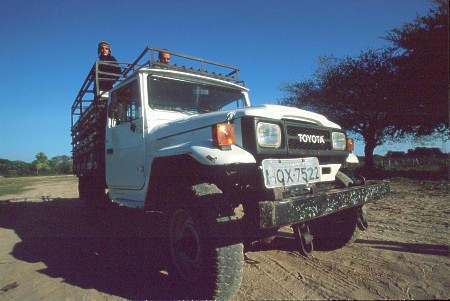
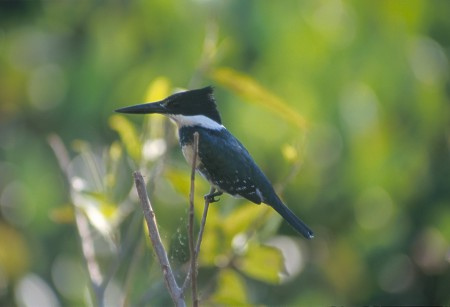
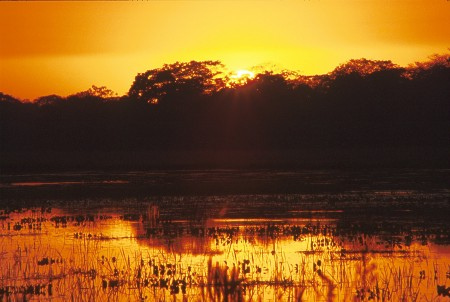


Banner image: View of Corumbá and surrounding Pantanal (Aminzinho Feres)
Other photos: Andrew Mercer
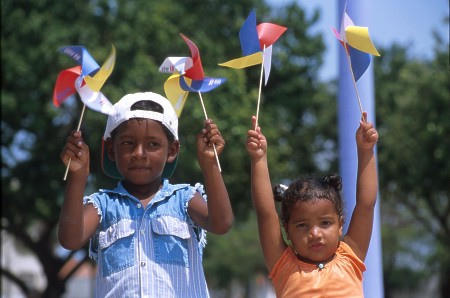
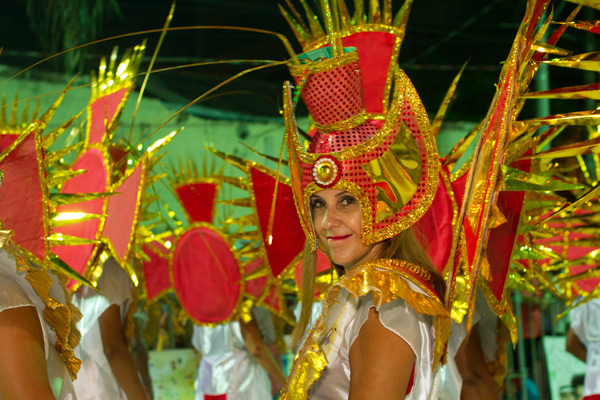
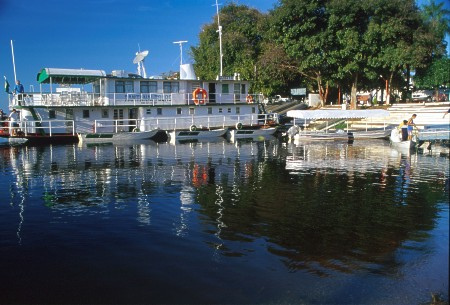
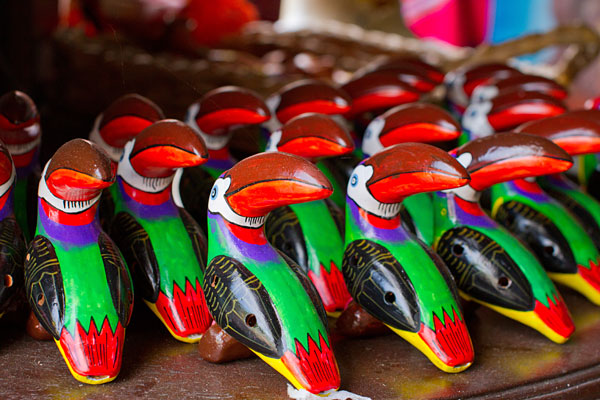
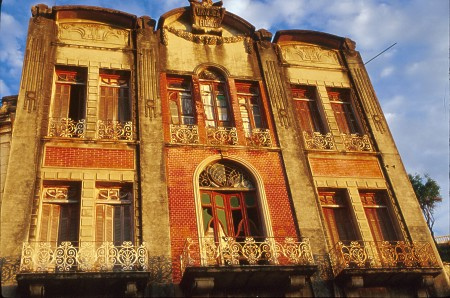
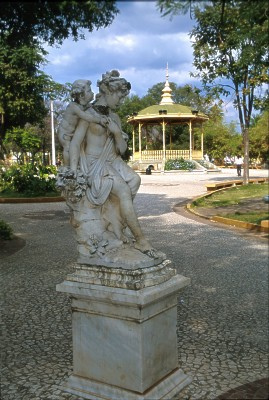
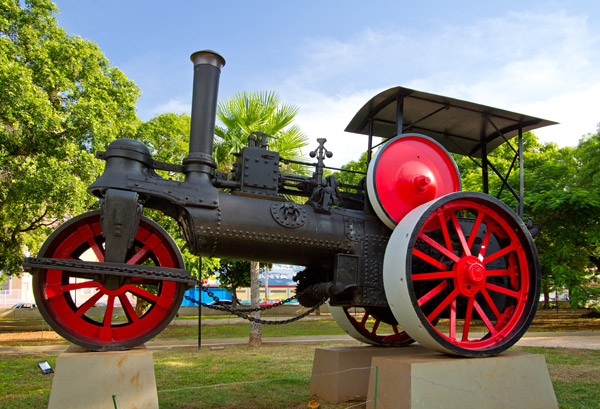
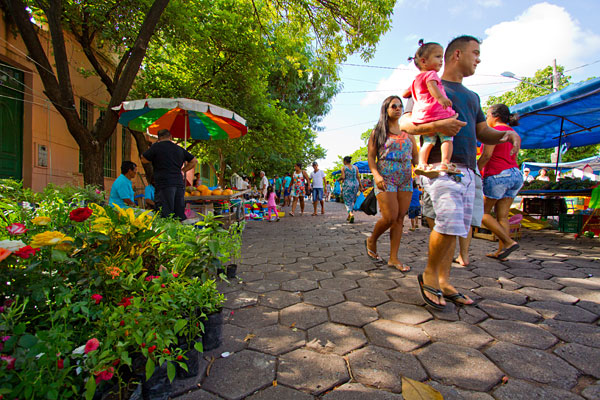


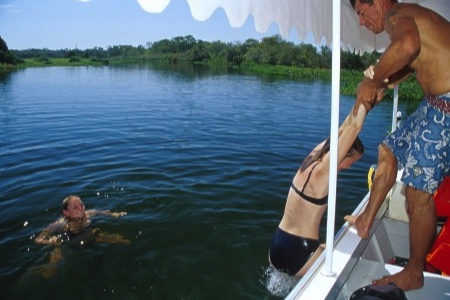



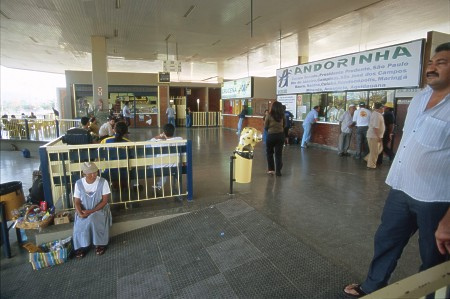
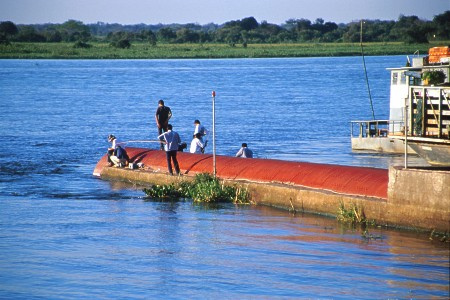
Pantanal Escapes